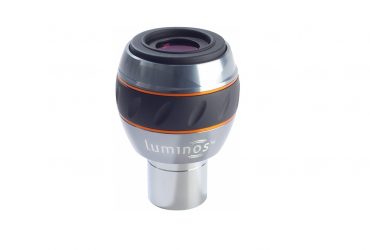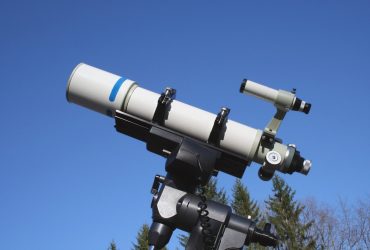How To Choose The Best Barlow Lens
A Barlow lens works by increasing the effective focal length of your telescope. It is especially useful if you have a short focal length telescope. By attaching a Barlow lens, you can achieve higher magnification powers without having to spend money on extra eyepieces.
The Meade Instruments #126 is the best 2x Barlow lens. It fits 1.25” eyepieces and provides double the eyepiece magnification for better planetary and moon observations.
The Orion 08704 Tri-Mag is the best 3x Barlow lens. It multiplies eyepiece magnification by three, providing an even more detailed look at celestial objects like Jupiter and Saturn.
The Svbony Barlow Lens is the best 5x Barlow lens for those looking to get the highest magnification out of their eyepiece. It’s a great choice if you want to zoom in on details such as the moon’s craters or Jupiter’s moons.
Barlow Lens Buying Guide
A Barlow lens is an affordable way to add more magnification options to your telescope. It increases the magnification power of an eyepiece by two, three or five (2x, 3x and 5x respectively).
Say you have two eyepieces: a 10mm eyepiece and a 30mm eyepiece. By using a 2x Barlow, you can create two more magnification options by doubling each of your eyepiece’s magnification power.
The 10mm eyepiece will have the magnification power of a 5mm eyepiece, while the 30mm eyepiece gives you the power of a 15mm eyepiece.
If you have a 1,000mm eyepiece, you’ll have at your disposal the following magnifications: 100x and 200x for the 10mm eyepiece; 33.3x and 66.6x for the second eyepiece.
So you don’t have to buy extra eyepieces.
A Barlow lens does lead to some loss of light but it’s very little – typically around 3%. You probably won’t notice that the image is slightly dimmer.
Barlow lenses are inexpensive; they cost about the same as a basic beginner eyepiece. All our picks below cost less than £50.
Here’s what to consider when choosing a new Barlow lens.
a) Magnification Power
The most common Barlow lenses are 2x, 3x and 5x. There are also some 2.5x Barlow lenses.
For most people, a 2x Barlow lens is enough to get you the level of detail you want without affecting viewing quality.
For some smaller telescopes, a 3x or 5x Barlow will result in a fuzzy or very dim image because of too much magnification power.
But if you already have a larger telescope that draws in a lot of light, you can use a 3x or 5x Barlow to ramp up your eyepiece magnification to the point where you can see craters on the moon.
Something to keep in mind when considering whether to get a 2x, 3x or 5x is the maximum useful magnification of your telescope.
For instance, using a 5x Barlow with a 10mm eyepiece might be too much for most telescopes. You’ll get a blurry and dim image. Same goes for a combo like a 3x Barlow and a 5mm eyepiece.
I recommend crunching some numbers for different Barlows to find the one that will prove most useful.
b) Eyepiece Compatibility
Make sure the Barlow lens is compatible with your eyepiece in terms of size. Depending on the diameter of your eyepiece, you can get a 1.25” or 2” Barlow lens.
c) Image Quality
Look for a Barlow lens with features such as multiple coatings and a blackened interior that reduce light distortions.
Best Barlow Lens Reviews
1. BEST 2x: Meade Instruments #126 1.25-Inch 2x Short-Focus Barlow Lens
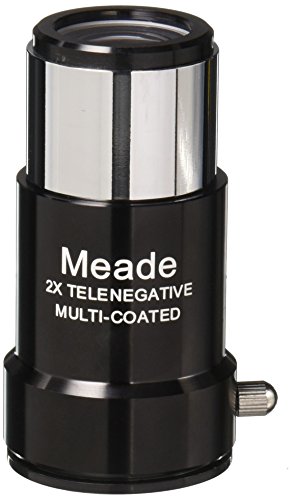
Pros
- Provides 2x magnification while maintaining image quality.
- Multi-coated optics maintain image sharpness and reduce distortion.
- In a refractor telescope, it can also provide 3x magnification when you insert the diagonal into the Barlow.
- Excellent build quality – guaranteed to last long.
Cons
- May make focusing harder on smaller telescopes.
Overview
For most beginner and amateur astronomy enthusiasts, the Meade Instruments #126 is the best Barlow lens for boosting magnification power while maintaining viewing quality.
It greatly improves magnification without causing any fuzziness or visible dimming.
So you still get a clear sharp image of Jupiter or the moon.
It fits 1.25” eyepieces. It’s shorter than most Barlow lenses and is not too heavy. Unless you have a very small telescope, it shouldn’t cause any tipping or vibration problems.
Note that the Meade Barlow Lens works with any telescope, whether from Meade or any other brand. As long as your telescope uses a 1.25” eyepiece, this Barlow lens should fit perfectly.
What It Does Best
The best thing about the Meade Instruments #126 Barlow lens is its ability to retain image quality even as it enhances magnification.
If you want a more detailed view of planets or the moon than your current eyepiece provides, the #126 Barlow works great. Multi-coated optics ensure you still get a sharp image.
The #126 is especially useful if you have a short focal length telescope. Instead of buying a high-magnification eyepiece, you can use the #126 with your current eyepieces to get better magnification power.
Flaws But Not Deal Breakers
The only issue is that it can make focusing harder on small telescopes. The weight of the Barlow, though low, can cause increased vibration that makes it more difficult to focus on an object in the sky.
But this is not a problem for most telescopes.
What Other Customers Think
Most customers were satisfied with the Meade Instruments #126 Barlow. For the price, they say it does a great job enhancing the magnification of their eyepiece.
They love that they can get more planetary detail without sacrificing image quality – that’s not always a guarantee with some Barlows.
Should You Buy It?
If you are looking for a Barlow that will double your eyepiece magnification, the Meade Instruments #126 Barlow is one of the best 2x Barlow lenses. We highly recommend it.
If you have a larger telescope that can take more magnification power without distortion, maybe consider our 3x Barlow lens below. You’ll get more details than the #126.
2. BEST 3X: Orion 08704 Tri-Mag 1.25-Inch 3x Barlow Lens
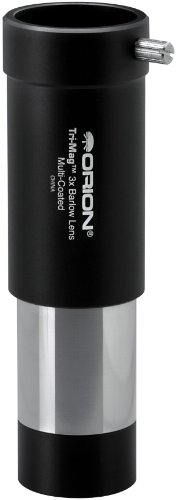
Pros
- Boosts eyepiece magnification by three – great for planetary and lunar observations.
- Ideal for short focal length telescopes.
- Multi-coated lens to improve image quality.
- High quality and durable aluminium housing.
- Affordable.
Cons
- High magnification makes it harder to keep image in view.
Overview
If 2x is not enough for you, the Orion 08704 Tri-Mag 3x Barlow lens will probably get you the level of detail you are after.
Unlike the 2x Meade Instruments Barlow, the Orion Tri-Mag increases magnification power by three. That’s a lot.
A 15mm eyepiece will have the same magnification power as a 5mm eyepiece. This is great for planetary and lunar observations.
You can see the rings of Saturn more clearly and if you focus your telescope on the moon, you can see some of the craters.
The Orion Barlow fits 1.25” eyepieces.
What It Does Best
It’s not automatic that higher magnification results in better viewing quality. Depending on the quality of the Barlow, it can result in a dim and fuzzy image.
That’s why we are impressed by this Barlow’s ability to retain image quality even with the increased magnification.
It does magnify light pollution more than a 2x Barlow, but that’s not a problem with the lens – it’s an issue with where you live.
If you can time your observations on a clear night or go out into the country where there’s less light pollution, the Orion Tri-Mag Barlow produces a sharp bright image.
The 3x magnification turns even an old scope into a great tool for planetary observations.
If you have a couple mid or low power eyepieces, the Orion 3x Barlow saves you the cost of investing in high-power eyepieces.
Just screw the eyepiece into this Barlow and you can see Saturn like you’ve never seen it before.
Of course, on some telescopes and higher-power eyepieces, the resulting magnification might be too much, resulting in a blurry image.
So do your math to make sure you don’t exceed your scope’s max useful magnification power.
Flaws But Not Deal Breakers
The main issue with the Orion Tri-Mag is one you can’t avoid with any 3x Barlow. Because of the high magnification power, objects quickly move out of view as the earth rotates.
One moment you have Saturn in your sights; after 10-20 seconds, it’s gone, forcing you to refocus.
It takes a bit of trial and error to get used to it but with time, you’ll be able to cope with this inherent problem.
What Other Customers Think
Despite the increase difficulty in focusing and the increased interference of light pollution, many customers are glad they got the 3x Orion Tri-Mag Barlow.
They can see clearer images of Saturn and other planets as well as the moon. They also got to save quite a bit of money on buying extra high-power eyepieces.
Should You Buy It?
If you are looking for a Barlow that will greatly increase your eyepiece’s magnification, allowing you to see more detailed images of the planet and moon, the Orion 08704 Tri-Mag 3x Barlow lens is a great choice.
You have to be careful though not to go too far with magnification power to avoid downgrading the image quality.
If you feel the 3x is not quite powerful enough for your needs, perhaps a 5x Barlow lens is what you are looking for.
BEST 5X: Svbony Barlow Lens 5X Metal 1.25″ Apochromatic Barlow Lens
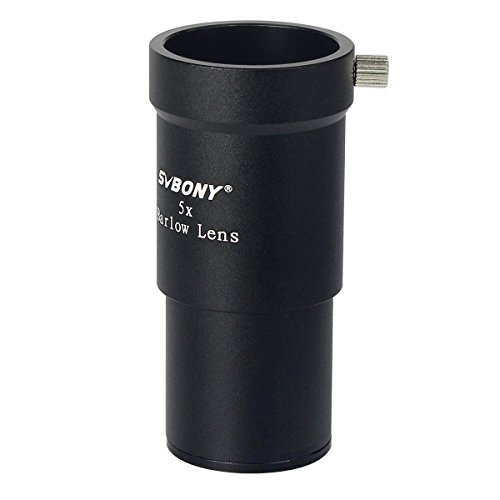
Pros
- Boosts magnification 5 times – provides detailed view of planets and the moon.
- Steel screw helps secure your eyepiece into place for easier focusing.
- Good quality metal housing backed by a lifetime warranty.
- Provides higher magnification power without reducing eye relief.
- Inexpensive.
Cons
- High magnification comes with several trade-offs – slight distortion, some blurriness and vibrations.
- Long and heavy. Can tip smaller telescopes or cause vibrations.
Overview
The Svbony Barlow Lens is one of the cheapest you can find. It’s cheaper than just about all other 2x and 3x Barlows.
But the most notable thing about it is its 5x magnification boost. It increases the magnification power of your eyepiece fivefold. Take the current magnification of your eyepiece and multiple it by five – that’s the magnification you’ll get with the Svbony Barlow Lens.
That’s mostly good, but it does come with several trade-offs.
Let’s start with the good part. 5x more power means you can see much more detail than what you get from a 2x or 3x Barlow.
If you’ve ever wanted a close-up of moon’s craters or a better view of Saturn’s rings, the Svbony Barlow Lens makes it possible.
It grants a 15mm eyepiece the power of a 3mm eyepiece.
As for the not-so-good part, don’t expect a sharp and clear image. Because of the greatly increased magnification, there’s more distortion. The image may appear blurry and a bit dim.
Be careful not to go over your telescope’s max magnification, which is easy to do with a 5x Barlow.
For instance, if you have a 20mm eyepiece and a 1,000mm telescope, the magnification is 50x. With the Svbony Barlow Lens, the new magnification is 250x.
If you exceed your scope’s magnification, the resulting image will be dim and fuzzy.
Overall, if you are willing to sacrifice some image quality the Svbony Barlow Lens is a good choice for highly detailed planetary and lunar observations.
For the price, it’s a great bargain.
What It Does Best
Most astronomy enthusiasts don’t need a 5x Barlow. It’s simply too much.
But for those who want to view moon’s craters or a closer look at Saturn’s rings, the Svbony Barlow Lens does a great job.
It’s also ideal for those who want to increase their eyepiece’s magnification power without sacrificing eye relief.
Most high-power eyepieces suffer from short eye relief, which can affect viewing comfort especially if you wear glasses.
With the Svbony Barlow Lens you can enjoy higher magnification power while using a lower-power eyepiece with comfortable eye relief.
Flaws But Not Deal Breakers
To be honest, some of these flaws are deal breakers – but not for everyone.
If you just want closer planetary and lunar observations, you’ll get a much sharper image from the 2x and 3x Barlows I’ve reviewed above.
But if you want to get real close, to the point where you can see moon’s craters, then the following issues may be worth tolerating.
The main one is image quality. Depending on your telescope and eyepiece, it can get a bit soft especially for more distant objects like Saturn.
The other issue is the Barlow’s weight and length. It affects the balance on some telescopes and can even make it tip over.
It also produces more vibrations even at the lightest of touches. This can make it harder to focus on an object.
The Svbony Barlow Lens comes with a steel screw that holds your eyepiece to the Barlow securely to minimize movements. It does help a bit though it doesn’t prevent all vibrations.
What Other Customers Think
Most customers agree that the Svbony Barlow Lens 5x magnification does come with several trade-offs. But many say these limitations are worth the increased magnification.
They do warn that it takes some trial and error to learn how to focus with the Barlow and that you need to time for the right atmospheric conditions, but the extra effort is worth it.
Should You Buy It?
If you want to get as close as you can to Saturn, other planets and the moon, the 5x Svbony Barlow Lens is a good choice.
If you want to retain a sharp image while increasing magnification, we recommend the 2x Meade Instruments or the 3x Orion Barlow instead.

